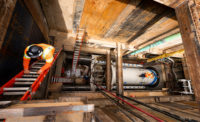California contractors are optimistic construction will gain traction in 2021. According to a recent AGC of California survey, 70% of responding contractors expect revenue and net profits to expand or remain even in 2021.
Contractors’ top concerns for2021 include workforce pipeline development, COVID-19 regulations and health and safety issues, and financial impact due to project disruptions and delays, according to AGC of California’s 2021 Industry Optimism survey. Seventy-eight percent of those surveyed expect hiring will stay the same or increase over 2020.
While the majority of the nation’s major metros reported employment contraction between February 2020 and February 2021 due to project cancellations, rising material prices and supply chain problems, California saw growth.
In the Sacramento--Roseville--Arden-Arcade metro area, construction employment hit its highest February level on record with jobs increasing by 3,100, or 4%, between February 2020 and February 2021. The San Diego-Carlsbad metro area added 1,600 jobs, or 2%,in the same period, while Hanford-Corcoran constructions jobs grew by 11% between February 2020 and February 2021.
The L.A. metro area of Los Angeles-Long Beach-Glendale lost 8,200 jobs, down 5%.
Peter Tateishi, chief executive of AGC of California says he was surprised by the survey’s results – he expected members to be “less enthused” about next year, instead they are “bullish about 2021.”
The health care sector took a hit during the pandemic as hospitals saw less activity during COVID as patients were relecutant to visit and delayed or cancelled revenue-driving elective surgergies The tenant improvement sector also fared poorly during the pandemic as offices closed and companies contemplate what a post-pandemic office with look like with new health and safety considerations, Tateishi says.
Meanwhile, public works and highway and transportation grew during the pandemic as projects moved at a faster pace thanks to lower traffic volume that allowed work outside traditional night shifts.
However, Ken Simonson, chief economist of AGC national worries another COVID setback could lag reopening the economy. “I think this degree of optimisim is a bit excessive,” says Simonson. “I don’t expect to see a strong rebound in non-residential construction this year.”
He expects “last mile” distribution facilities, those that deliver packages to homes and handling cold goods in transit, and data centers to remain “hot” markets. K-12 school construction will also do well in 2021, but retail and hotel/hospitality are down substantially.
“The biggest challenge for construction is materials costs and availability,” says Simonson, who points to lumber and steel prices and damage at petroleum chemical plants in Texas that are the building clocks for plastics such as resins, plumbing fixtures and vinyl siding. “Right now, the supply is very limited and price are shooting up.”
Congestion at the Ports of Los Angeles and Long Beach are having the trickle effect of holding up parts of appliances and machinery, delaying some construction projects and driving up costs.
Steve Agor, vice president of business development, at Skanska USA Civil says the firm’s California clients are optimistic. “Our customers are now reporting the revenue impact they forecasted is showing to be less than forecasted,” says Agor, who points to new projects that are bidding or planning to be bid, though with, at times, delayed schedules. “After a slower 2020 advertisement of new projects, procurement schedules appear to be ramping up in the second half of 2021, again for public works infrastructure projects.”
Simonson says Washington state employment is already back to the February 2020 level (one of only six states) in part due to Amazon’s, Microsoft’s and Costco’s growth.
Agor says ongoing public works projects in California’s San Diego, the Inland Empire, the Los Angeles metro area, the Bay Area, and Seattle, have continued with little to no stoppage due to their designation by local and state agencies as essential work. “Project delays and cost impacts have occurred for a variety of reasons, from short term work force shortage to supply chain impacts as some locations throughout the US and the world were unable to either manufacturer their product or deliver their product to project sites,” Agor says.
Agor points to Skanska’s work as part of the Los Angeles SkyRail Express team, selected to provide Project Development Phase services for LA Metro’s Sepulveda Transit Corridor project over the next four years. Earlier this month, LA Metro awarded LA SkyRail Express, with team members John Laing, BYD, Skanska and HDR, a $63.6 million PDA contract to develop a proposed monorail concept that aerially allign primarily within the I-405 right-of-way between the Valley and Westside. The baseline cost for building the monorail concept is $6.1 billion.
Dave Valentine, at Hensel Phelps, says he is “very optimistic” about the Northern California market moving forward, and that, “2020 was oddly not bad” with 2021 on track to be “solid.” “Things are very competitive, but there are opportunities to pursue,” Valentine says – and points to strength in higher education, healthcare, government buildings, life sciences, mission critical/data centers, industrial buildings and transportation.
“The pandemic certainly impacted health-care providers significantly, but due to the pending last SB 1953 deadline, which is 2030, we’re starting to hear more about what some may be planning, which is very exciting,” Valentine says.
California Senate Bill 1953 is an amendment to the Alfred E. Alquist Hospital Seismic Safety Act of 1983 and part of the California Health and Safety Code that establishes a seismic safety building standards program under OSHPD′s jurisdiction for hospitals built on or after March 7, 1973.
Valentine notes that Hensel Phelps’ northern California aviation work suffered due to greatly reduced passenger thru-put, but the aviation sector is in recovery mode.
Scott Russell, group leader of Arup’s Los Angeles office, says the firm is also optimistic about 2021. “In California, we are continuing to see a consistent amount of work with our healthcare and aviation clients. We are also seeing sustained levels of activity surrounding projects focused on sustainability, resiliency and equity as many of our clients increasingly look to invest in this type of work,” says Russell.
Workforce
Jon Preciado, Southern California District Council of Laborers, says the pandemic has not slowed down work and, in 2020, Southern California laborers saw working hours that far exceeded the preceding three years.
“However, we continue to believe that we could be doing even more projects and hours if funds for publicly funded projects were more quickly dispersed,” Preciado says. “We have not experienced any issues with recruiting, training, and retaining members, and have experienced tremendous membership growth that has seen our membership numbers top 32,000 in 2020.”
Agor says workforce development continues to be a long-term concern, especially as more of the work force reaches retirement age, but notes there are many companies, associations and labor groups making significant headway recruiting and training the next generation of labor.
“The need is not just limited to construction workers,” says Agor, who notes that in the public works sector, employment remained steady throughout the pandemic which he expects to continue. “The industry is always looking to recruit engineers, project schedulers, accountants, project managers, and many other roles to meet the needs of the infrastructure construction industry.”





Post a comment to this article
Report Abusive Comment